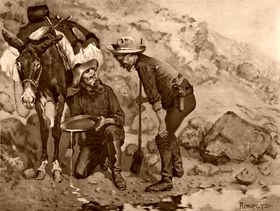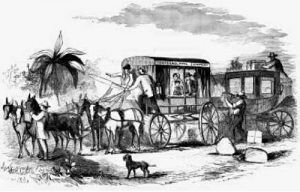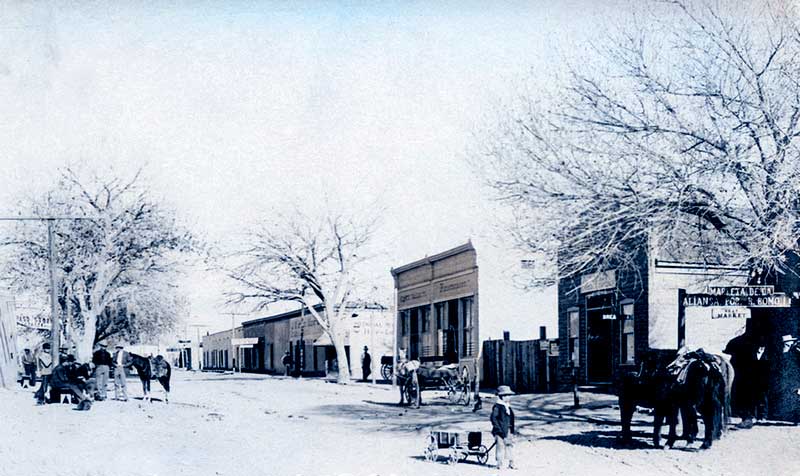Bronco Sue Yonkers, who was also known as Sue Warfield, Sue Rapier, Sue Stone, and Sue Black, was a lusty Welsh girl who turned the heads of men and could shoot as well as any of them. She also left a trail of unlucky men in her wake as she made her way through the Wild West.
Born as Susie Warfield in Wales on September 11, 1854, she immigrated with her parents to the United States when she was just a child. The family made their way to the Nevada mining camps where little Susie learned daring horseman skills and how to use a pistol as well as any man.
When she was just 15-years-old, she married a mine promoter named Thomas Rapier, and the couple would have two sons. They moved to California, where on one occasion, her husband was wounded during an Indian raid, and Sue showed her devotion by bravely rescuing him. But it wouldn’t be enough. When Thomas’s Downieville mine played out, Sue left him and made her way back to Nevada.
Quickly she moved on and was next known to be working with a cattle rustler in Elko County who went by the name of Colonel Robert Payne. During these years, she survived several gunfighting scrapes and wound up in court several times but was never convicted by the all-male juries. She was not yet 20-years-old.
Soon, she moved on again, this time to Colorado, where she went by the name of Susie Stone. There she operated a stage line between Conejos and San Antonio.
By 1882 she had married again, this time to a man named Jack Yonkers. The pair moved to Wallace, New Mexico, where they ran a saloon. A year later, Bronco Sue moved again to White Oaks, New Mexico, which was a busier settlement. But, upon her arrival, there was no sign of Jack Yonkers; instead, she was with a man named Robert Black. Her story was that Yonkers had died of smallpox and that Robert Black had helped her bury him at Alkali Flat. However, there was no known outbreak of smallpox in that area at the time. The pair opened a saloon in White Oaks, which was prosperous, and the couple soon bought a ranch.
However, when the boom at White Oaks began to falter, they moved on again, this time to Socorro, New Mexico. In the meantime, Sue had convinced Black to sell his cattle. In Socorro, Sue ran a boarding house, and Black opened a saloon. When Black lost his saloon in about August 1884, he and Sue got into a drunken argument, which resulted in him being arrested and held overnight.
The next morning when the town marshal released Black, he was warned not to go home as Sue was well-armed and willing to use her superior shooting skills. However, Black ignored the warning and returned home, where he was shot and killed by Bronco Sue. When she was arrested, she told the court that Black had come after her with an ax, and she had shot him in self-defense. She was released before any indictments were made and fled town.
She next wound up in Tularosa, New Mexico, where she was known to have been friendly with a man called Big John Good, who had recently arrived from Texas. Good, who had arrived with a large herd of cattle, had a long history of being a bully and throwing his weight around.
However, their relationship ended when Mrs. Good and John’s children arrived. Bronco Sue moved on again and was soon involved with a rancher named Charley Dawson and began training horses. There, she received the nickname of “Bronco Sue.”
Though Good’s wife and family were now present, it didn’t stop John Good’s jealousy at seeing Bronco Sue involved with someone else. Good challenged Dawson to a duel at La Luz to settle the matter, and on December 8, 1884, Good shot Dawson dead.
Good was arrested but acquitted on the grounds of self-defense.
But, Sue’s attendance at the event reminded authorities that she had been a suspect in the Robert Black case. She was soon arrested on murder warrants from Socorro.
She was at last tried for Robert Black’s murder in 1886. During her trial, newspapers referred to her as the “Lucretia Borgia” of the West. Alfred J. Fountain, the famed attorney, defended her on the charge, and she was, once again, found not guilty and released by an all-male jury.
The day after her release, she departed for Arizona and was never heard from again.
Kathy Weiser-Alexander, updated December 2020.
Also See:
John Good – Gunfighting Rancher
Other Characters in Frontier History
Sources:
MacKell, Jan; Red Light Women of the Rocky Mountains, University of New Mexico Press, 2011.
The Mountain Voice



